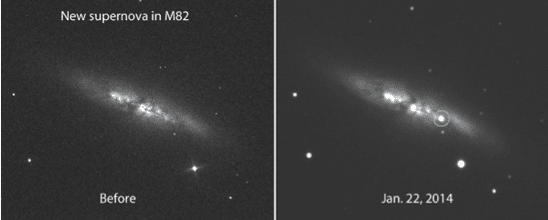The discovery of this extragalactic supernova will provide an opportunity for students and amateur astronomers to study such an event utilizing remote robotic telescopes for astronomy research and education. Students and amateur astronomers could take sequential images of the galaxy over a period of nights to compare the supernova's change in magnitude.
 |
| Before and after photos of the galaxy M82 showing the appearance of a brand new 11.7 magnitude supernova.
Image by E. Guido, N. Howes, M. Nicolini |
Spectra showed it to be a Type Ia supernova (an exploded white dwarf) with debris originally expanding at up to 20,000 kilometers per second. It is significantly dimmed and reddened by dust in M82 along our line of sight. By one estimate, it would be two magnitudes brighter if we were seeing it in the clear.
< Because this new supernova is currently at magnitude +11 to +12, it's definitely not visible to the naked eye. You’ll need a 4-inch telescope at least to be able to see it. That said, at 12 million light-years away, this is (at the moment) the brightest, closest supernova since SN 1993 J exploded in neighboring galaxy M81 approximately 21 years ago. M81 and M82, along with NGC 3077, form a close-knit interacting group.
M82 is a bright, striking edge-on spiral galaxy bright enough to see in binoculars. Known as the Cigar or Starburst Galaxy because of its shape and a large, active starburst region in its core, it’s only 12 million light-years from Earth and home to two previous supernovae in 2004 and 2008. Neither of those came anywhere close to being as bright as the discovery, and it’s very possible the new object will become brighter yet.
The supernova occurred when the dwarf packed enough pounds to reach a mass 1.4 times that of the Sun, and it can no longer support itself. The star suddenly collapses, heats to incredible temperatures, and burns up explosively in a runaway fusion reaction. What we see here on Earth is the sudden appearance of a brand new star within the galaxy’s disk. Of course, it’s not really a new star, but rather the end of an aged one.
T24 is the largest iTelescope system in the Northern Hemisphere. It is big, it is beautiful. Situated under dark and clear skies deep in its Sierra mountains remote location in Northern California USA. This is the same location Insight Observatory plans to host the 16" Dream Astrograph Telescope.

No comments:
Post a Comment